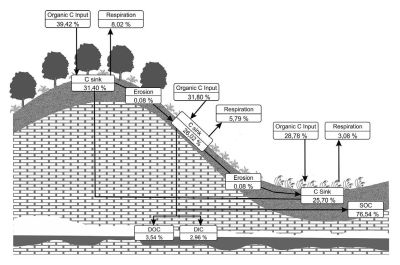The Nature of Carbon Flux in Gunungsewu Karst, Java-Indonesia
DOI:
https://doi.org/10.3986/ac.v45i2.4541Ključne besede:
soil organic carbon, carbon flux, Gunungsewu, Java, karst carbon sinkPovzetek
The research documented here aims to clarify the transport and fate of carbon species that evolved in a typical conical karst system in Gunungsewu. Special interest is attributed to the estimate of carbon flux by considering the conical karst as a whole system. It includes carbon input to karst area, soil respiration, SOC, soil CO2, particulate-dissolved and organic carbon, as well as dissolved organic carbon. The research was conducted between 2012 and 2015. Two study sites were selected to represent different morphological and hydrogeological settings. Carbon input was collected for one year round on the basis of conical hill topo-sequence. Carbon input included in this research was litter fall, plant residue, and organic fertilizer. Incorporated with field measurement, soil samples were also collected for SOC estimation. DIC and DOC were estimated from the underground river of Gilap. The results show that carbon flux in the Gunungsewu karst is favored by the agricultural land uses and practices. Accordingly, the organic carbon input to the karst area is governed by spatial distribution of agricultural land uses and practices. Organic carbon input tends to be in the order of organic fertilizer > litter input > and plant residue. Soil CO2 varies in depth and season. Soil organic carbon also varies seasonally, of which the higher content occurs in the rainy season. Most of the carbon is stored as SOC, 20 % is emitted to the atmosphere through soil respiration, and 9 % is transferred to the deeper zone through a hydrological cycle in the form of dissolved organic carbon and particulate-dissolved organic carbon. The results suggest that carbon sink in the karst area is ten order higher than that previously estimated from DIC.
Key words: soil organic carbon, carbon flux, Gunungsewu, Java, karst carbon sink.
Prenosi

Prenosi
Objavljeno
Kako citirati
Številka
Rubrike
Licenca
Avtorji jamčijo, da je delo njihova avtorska stvaritev, da v njem niso kršene avtorske pravice tretjih oseb ali kake druge pravice. V primeru zahtevkov tretjih oseb se avtorji zavezujejo, da bodo varovali interese založnika ter da bodo povrnili morebitno škodo.
Podrobneje v rubriki: Prispevki




